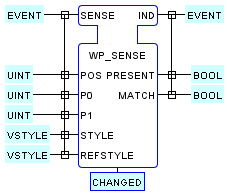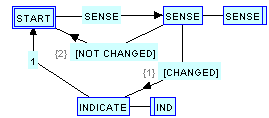
EVENT_INPUT
SENSE WITH STYLE,REFSTYLE,POS,P0,P1;
(* Input change notification *)
END_EVENT
EVENT_OUTPUT
IND WITH PRESENT,MATCH;
(* Output change indication *)
END_EVENT
VAR_INPUT
POS : UINT;
(* Workpiece position on conveyor (0-100%) *)
P0 : UINT;
(* Position sensor lower limit *)
P1 : UINT;
(* Position sensor upper limit *)
STYLE : VSTYLE;
(* Workpiece style *)
REFSTYLE : VSTYLE;
(* Style to be sensed *)
END_VAR
VAR_OUTPUT
PRESENT : BOOL;
(* Workpiece is present between P0 and P1 *)
MATCH : BOOL;
(* Workpiece is present and STYLE matches REFSTYLE *)
END_VAR
VAR
CHANGED : BOOL;
(* PRESENT and/or MATCH value has changed *)
END_VAR
An instance of this function block type models the operation of a
dual set of sensors which can sense both the presence of a workpiece
at a position POS between the two positions
P0
and
P1
inclusive, and whether the type of the workpiece given by the
STYLE
input matches the reference style
REFSTYLE
(an instance of the VSTYLE data
type) when the workpiece is present. It is typically used to position
a sensor pair at a specified location along a conveyor modelled by an
instance of the CNV_MDL type
or its enclosing CNV_MDLL or
CNVG_MDLL types, for
instance as in the sortation/inspection
testbed.
As modeled by the Execution Control Chart (ECC) and Algorithm shown
below, the operation of the block is triggered by an event at the
SENSE
input and results in an event at the
IND
output when the value of either or both of the
PRESENT
and
MATCH
sensors changes.

ALGORITHM SENSE IN Java :
final boolean newpres
= (POS.value>=P0.value)
&& (POS.value<=P1.value)
&& (STYLE.value != VSTYLE.NONE);
final boolean newmatch
= newpres && (STYLE.equals(REFSTYLE));
CHANGED.value
= (newpres != PRESENT.value)
||(newmatch != MATCH.value);
if(CHANGED.value){
PRESENT.value = newpres;
MATCH.value = newmatch;}
END_ALGORITHM